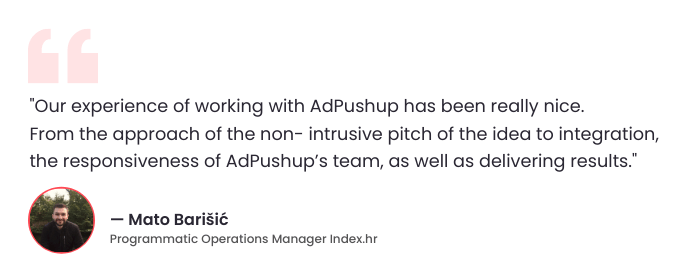In the fast-moving world of digital advertising, sticking to one channel is not enough.
Display ads used to be the dominant channel. Now, marketers are making video their go-to advertising medium.
Even though videos cost more to produce than static images, they earn far higher conversions. Marketers everywhere are starting to take notice.
80% of marketers feel positive about the returns they earn through video marketing. Video’s ability to channel emotions and boost likeability has proven itself a critical advantage in the competitive world of ad publishing.
Publishers, who were focusing entirely on display ads, are now changing their tactics.
However, display ads haven’t gone obsolete overnight. Marketers still use them to guide users along the sales funnel. But to keep up with ever-changing trends, marketers must embrace video ads.
The key to incorporate video in advertising is using the medium to build and nurture a high-value audience.
For publishers, that means making the transition from display ads to video ads. This requires taking an omnichannel approach. From there, you can shift focus to your best-performing ad channels.
But first, let’s get our definitions straight:
What are Display Ads?
Display ads are static image-based advertisements shown to users on web pages and applications. These ads are mostly created by advertisers and displayed on publishers’ ad inventory through either the programmatic trading process or direct deals.
Display ads can come in various forms:
- Banner ads are by far the most common. These big banner images are present on almost every major website out there.

- Interstitial ads have gained in popularity. These are full-screen ads that appear during transition points in mobile applications. You can see these ads in mobile games like Bejeweled, Candy Crush, and Angry Birds.
- Overlay ads are pop-ups. These are commonly used to serve text or HTML content on top of videos.

What are Video Ads?
In the advertising industry, the term “video ads” doesn’t apply to all advertisements that use video as a medium. “Video ads” are distinct from “TV ads” (i.e. commercials) and other types of video content.
The term refers strictly to video advertising content served through digital channels. That means social media, YouTube, and web applications.
People are increasingly choosing video content over text. According to Wordstream, 59% of executives say they would rather watch a video than read text. As a result, publishers are focusing on serving video ads over display ads.
There are many types of video ads. Bumper ads, outstream ads, and masthead ads are all examples of video ad types:
- Bumper ads are six-second non-skippable YouTube ads. They also run on Google-partnered websites and apps.

- Outstream ads expand the reach of video ads on mobile devices. They don’t run directly on video hosting services. Instead, they run on banners, interstitial ad spaces, and news feeds.

- Masthead ads take up the entire hero image space of a website or media platform. Most public video hosting platforms and streaming services offer masthead ad space to select publishers.

Making the Transition
For ad creators, video ad content requires a unique approach. Producing a single video is more expensive than creating a dozen static banner ads. As a result, video ads demand better targeting than static banners.
Here are some steps you will want to take to make the most of this opportunity:
1. Enable Advertisers to Track the Customer Journey
Remarketing tools that let advertisers track user behaviors and clicks are a critical part of the video ad environment. Your video hosting platform should support data capture and analysis. This allows your users to qualify content consumption and serve ads that speak to consumers’ needs.
While YouTube is undeniably the most popular video platform for publishers, it comes with strict limitations. YouTube monetizes its users’ content. That means you don’t get to. Publishers need to focus on video hosting solutions that offer monetization to users.
2. Deliver Content for Every Step In That Journey
A six-second video ad may help showcase your brand, but that’s not enough time to make a solid argument. You need to be able to serve the right ads at the right times, focusing on longer advertisements for qualified leads. The most popular video ad length is 30 seconds. Make sure your viewers are invested enough to truly benefit from that time.
This means taking out advertising spots in a wide number of contexts. Where are your users more likely to remain engaged with your content for 30 full seconds? Social media? Third-party web pages? Your own home page? Do your research and make an educated decision.
3. Implement the Right Video Monetization Solution
Programmatic video advertising relies on monetization. The two most common ad tag templates in use today are VAST and VPAID:
- VAST is an XML script that communicates between the video player and the ad server. It is a popular standard that automates ad delivery efficiently. It can also provide some insight into advertising effectiveness.
- VPAID is an ad template that offers more comprehensive ad performance and analysis. It is a more complex solution, but the data it gathers is more reliable than what VAST offers.
Publishers need to choose a video monetization solution that maximizes their ability to reliably serve ads and gather data on user engagement with those ads. Without that crucial capability in place, tracking and dedicated content delivery are not possible.
4. Choose a Video Hosting Platform That Can Deliver
Publishers should not jump to the most popular video hosting platform only because everyone is doing it. In fact, the largest and most popular platform may be the least-suited to publishers’ interests.
This is because even though platforms like YouTube and Facebook are not publishers, they monetize content the way publishers do. The only reason they avoid defining themselves as publishers is to avoid legal liability for the content they host. Their monetization policies support their ability to host content for free, which carries costs for publishers.
This is great for content producers and everyday users. It is not so great for publishers, who have no reason to give up their monetization rights so easily. Your video hosting platform should offer you the tools you need to optimize monetization through digital ad channels.

Best Practices for Video Ads During Transition
Making the transition from display ads to video ads is not an easy task. Publishers need to make the most of their existing content while leveraging the power of video. Some of the best paths to success include:
- Recommend advertisers turn static images into video ad slideshows. Facebook recommends repackaging display ad assets into lightweight slideshows in order to quickly transform display content into video content. Advertisers who have followed their advice have seen 20-30% conversion rate boosts. In case of direct deals, encourage your advertising partners to adopt the best practices for the medium you’re focusing on.
- Establish inventory specifications that maximize user engagement. If you invested in a video hosting solution that supports behavioral analytics, you can use that data to your advantage. Look at your users’ engagement data and have advertisers deliver video ads optimized accordingly. You can even trim advertisers’ videos to fit, but having them simply deliver optimal content is best.
- Optimize ads to not rely on audio. Background audio is an incredibly useful tool for desktop users. But it plays a far less critical role for mobile users. Many mobile users keep the sound off when engaging with video content. Make sure the content’s message is clear, either through closed-captioning or on-screen animation.
- Start building your own content environment. With a customization-friendly video hosting service onboard, you can create a Netflix-like user experience for all of your published content. Doing this will keep users on your websites and away from your competitors’. Keep the user experience consistent everywhere your content goes.
- Use analytics to constantly improve ad effectiveness. Your publishing success is directly related to your ability to optimize content for audiences. You can’t perform that optimization without solid analytics. Your video hosting provider has to let you know when ads are more effective – before, during, or following videos.
Also Read: 7 Tips To Increase Programmatic Video Ad Revenue
Final Word
Publishers looking for video hosting partners have plenty of options to choose from. The big-name free platforms will always be major players in this space. But the best publishers consistently steer themselves towards more value-oriented offerings.
Making the switch from display ads to video ads is a delicate task. Publishers need to make sure they have all the resources they need to make that process a successful one.
This is a guest post by Oren Shmulevich. He is a passionate video marketer and CEO of Cincopa, a digital asset hosting and management solution. With in-depth analytics, powerful integrations, and unique video features, Cincopa enables users to untap their videos’ true potential. Cincopa offers best-in-class analytics with a seamless user experience. The ability to constantly fine-tune your ad campaigns to deliver better results is going to make a major impact. That’s the kind of functionality great publishers demand, and your organization should be no different.

Shubham is a digital marketer with rich experience working in the advertisement technology industry. He has vast experience in the programmatic industry, driving business strategy and scaling functions including but not limited to growth and marketing, Operations, process optimization, and Sales.






